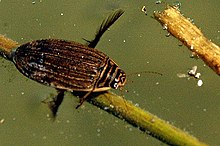Common furrow swimmer
| Common furrow swimmer | ||||||||||||
|---|---|---|---|---|---|---|---|---|---|---|---|---|

Common furrow swimmer ( Acilius sulcatus ) |
||||||||||||
| Systematics | ||||||||||||
|
||||||||||||
| Scientific name | ||||||||||||
| Acilius sulcatus | ||||||||||||
| ( Linnaeus , 1758) |
The common furrow swimmer ( Acilius sulcatus ) is a beetle from the family of the swimming beetles (Dytiscidae).
features
Beetle
The beetles are 15 to 18 millimeters long. The chitin armor has a yellowish primer. There are also many small black dots on the wing covers . There are two wide black stripes horizontally on the pronotum and a yellow stripe between them. On the head you can clearly see a black V-mark between the eyes. The scutellum is dark. The outline of the body is oval without a clear separation between the head, pronotum and abdomen, which gives the beetle a streamlined shape in the water. The males have smooth wing-coverts, the females have hairy longitudinal grooves on them. The feelers are thread-shaped. The males have one large and about 270 small suction cups on the front legs and 16 small suction cups on the rear legs, which the females lack. Long bristles can be seen on the hind legs, which the beetle uses as an oar to move.
Larvae
The larvae are elongated in shape and very narrow in the front (front breast) and much wider in the rear. When fully grown, they reach body lengths of around 3 cm. The narrow and long 8th and 7th abdominal segments each have a wide hem of swimming hair. The mandibles are short and dagger-shaped.
Similar species
- Acilius canaliculatus . The common furrow swimmer has a distinct black “V” between the eyes and in front of it another black spot that is drawn out “V” -shaped to the rear. In Acilius canaliculatus, on the other hand, the black drawing around the light field between the eyes in front is only a simple "V" pointing backwards.
Occurrence
The animals are widespread throughout the Palearctic , including far in the north. They are often found in small standing water, sometimes even in puddles. They also live at great heights.
Way of life
The beetles swim constantly and practically never rest. They prey on small invertebrates that are crushed in front of the mouth. Since the animals need air to breathe, they occasionally have to come to the surface. There they renew their air reserves, which they carry with them in the water under their wing covers. The beetles also fly overland in search of new habitats. When mating, the male holds onto the female's front legs with the help of his suction cups. The females then lay around 500 eggs in groups of 30 to 50 on rotten wood, moss or on the damp bank above the water surface. The larvae are similarly predatory as the adult animals. However, the prey is digested and sucked out by the larva before the mouth. Pupation takes place above the water surface. The finished beetles then hatch from the pupae .
literature
- Harde, Severa: Der Kosmos Käferführer, The Central European Beetles , Franckh-Kosmos Verlags-GmbH & Co, Stuttgart 2000, ISBN 3-440-06959-1
- Jiři Zahradnik, Irmgard Jung, Dieter Jung et al .: Käfer Central and Northwestern Europe , Parey Berlin 1985, ISBN 3-490-27118-1
- Carl Wesenberg-Lund. Freshwater insect biology , Gyldendalske Boghandel. Nordisk Forlag and J. Springer, 1943.


